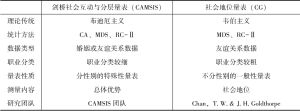章节
社会分层研究中的社会互动距离量表
摘要
社会互动距离分析方法从职业群体的互动模式出发确立不同职业之间的社会距离,建构社会分层量表,为社会分层研究提供了一种独特的“关系型”分析视角。剑桥社会互动与分层量表(CAMSIS)是这一研究传统最具代表性的研究成果。保罗·兰伯特和戴夫·格里菲斯合著的《社会不平等与职业分层:社会距离分析的方法与概念》一书系统地介绍了社会互动距离分析方法的发展历史以及CAMSIS的理论传统和建构方法。本文以此书为基础,进一步挖掘该领域的相关文献,对社会分层研究中的社会互动距离分析传统进行梳理,并对CAMSIS的基本原理进行介绍与评议。
作者
李明 ,清华大学社会科学学院博士研究生。
检索正文关键字
章节目录
- 一 引言
- 二 社会互动距离分析方法
-
三 社会分层研究中的社会互动距离量表:CAMSIS简介
- (一)理论渊源与基本假定
- 1.社会关系的同质性和内配性
- 2.“差别化交往”与社会结构的关系
- (二)CAMSIS的发展历程
- (三)CAMSIS的建构流程与方法
- (四)CAMSIS的测量内容及有效性
- (一)理论渊源与基本假定
-
四 CAMSIS对社会分层研究的贡献
- (一)把社会关系带回社会分层研究的中心
- (二)强调对职业社会意义的关注
- 五 CAMSIS的效度问题及“阶级”“地位”之争
- 六 结语
相关文献
查看更多>>>



